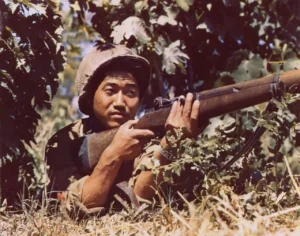During the early years of the Civil War, the Union cavalry was often outclassed by Confederate troopers. Rebel cavalrymen became legendary for their exploits against federal horsemen, often riding circles around them and routing them on numerous occasions. Eventually, through the implementation of improved organization, training, weaponry, and leadership, Union troopers began to match the skill of their rebel adversaries. Among the Union horsemen that contributed to the improvement in Union cavalry was John Buford.
John Buford was born on 4 March 1826 near Versailles, Kentucky, into a family with a proud military heritage. His father was a militia officer, his paternal grandfather fought in the Revolutionary War with COL Henry “Light Horse Harry” Lee, and his older half-brother, Napoleon Bonaparte Buford, graduated from West Point in 1827.
In 1844, he followed in his half-brother’s footsteps and earned an appointment to West Point, where he earned solid marks and graduated sixteenth in a class of thirty-eight in 1848. He was brevetted a second lieutenant in the Cavalry and was assigned to the 1st U.S. Dragoons at Jefferson Barracks near St. Louis, Missouri.
Upon arriving at Jefferson Barracks, however, Buford was soon reassigned to Fort Scott, Missouri, where he became seriously ill, but recovered. After six months with the 1st Dragoons, Buford was promoted to full second lieutenant. Shortly after his promotion, he was reassigned to the 2d Dragoons, but quickly found himself back with the 1st Dragoons as the regimental quartermaster.
After an extended furlough in the summer of 1851 in Kentucky, where he began courting his future wife, Buford was posted with the 2d Dragoons at Fort Mason, Texas. While he saw some action against Indians, Buford spent much of his time once again as the regimental quartermaster, much to his frustration. In July 1853, he was promoted to first lieutenant and reassigned to Company H, 2d Dragoons, in the New Mexico Territory, but ended up back at Jefferson Barracks for more garrison duty.
In October 1855, Buford finally saw action in the field that he had longed for when he took part in the the Battle of Blue Water in Kansas against the Sioux Indians. Two years later, Buford and the 2d Dragoons formed part of the Utah Expedition, which was commanded by COL Albert Sidney Johnston and sent to the Utah Territory to put down a revolt by Mormon settlers. During the campaign, Buford once again served as regimental quartermaster and efficiently coordinated logistics for the expedition.
After his promotion to captain in March 1859, Buford was briefly assigned to Carlisle Barracks to train new cavalry recruits before being sent west to fight Indians in California. During the months leading up to the Civil War, he was offered command of Kentucky’s secessionist militia but refused to renounce his loyalty to the Union.
Once hostilities broke out between North and South, Buford and his regiment, redesignated the 2d Cavalry Regiment, marched overland from Fort Leavenworth, Kansas, to Washington, DC. In the first year of the war, he served as a staff officer in the defenses of Washington and remained in the capital during the Peninsula Campaign. Knowing that his talents were being wasted, MG John Pope, commander of the newly formed Army of Virginia, rescued Buford from his administrative job in July 1862, promoted him to brigadier general, and gave him command of a cavalry brigade. He fought in the Battle of Second Bull Run (29-30 August 1862) and was so badly wounded during the Union withdrawal that he was originally reported as dead. He also served in the Antietam and Fredericksburg Campaigns later in the year
Upon MG Joseph Hooker’s reorganization of the Army of the Potomac’s cavalry in early 1863, Buford was placed in command of the Cavalry Corps’ reserve brigade and participated in MG George Stoneman’s poorly conceived cavalry raid during the Battle of Chancellorsville. During the Confederate movement north after Chancellorsville, Buford commanded a cavalry division, fought at Brandy Station, and skirmished with the rebel cavalry screen at Aldie, Middleburg, and Upperville, while shadowing the Confederate Army of Northern Virginia.
On 1 July 1863, two brigades of Buford’s division clashed with the leading elements of Confederate LTG A.P. Hill’s corps west of Gettysburg and initiated the most important battle of the war. Buford’s dismounted troopers held off the rebel advance and allowed Union reinforcements to arrive. The precious time bought by Buford allowed MG George G. Meade to establish strong defensive positions around Gettysburg and make a stand that ultimately resulted in a great Union victory.
Buford continued to serve in the Army of the Potomac after Gettysburg until he fell ill with typhoid fever in November 1863. As he lay dying in Washington, he was presented with a commission promoting him to major general of volunteers. He died on 16 December 1863 and is buried at West Point.





